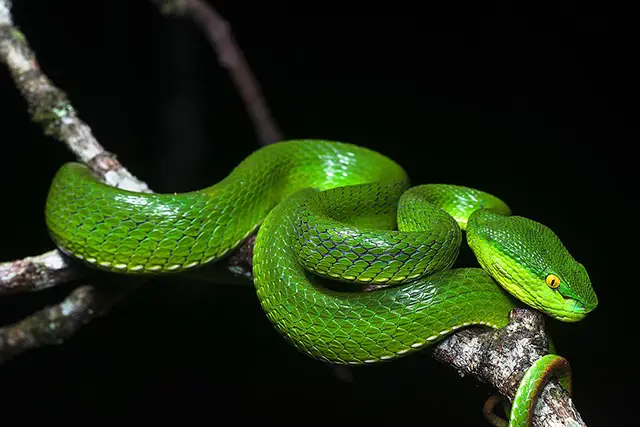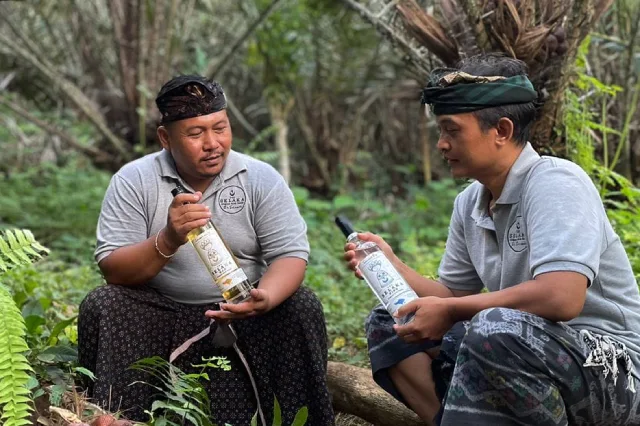Things to Do in Bali
Green Tree Pit Viper in Bali
The Green Tree Pit Viper, scientifically known as Trimeresurus albolabris and locally called Ular Hijau Ekor Merah, is a striking and dangerous snake species found in Bali. These pit vipers are easily recognizable by their bright green coloration and the distinctive red or brown tip of their tail. They are equipped with heat-sensing pits located between their eyes and nostrils, which they use to detect warm-blooded prey even in the dark.
Growing up to 1 meter in length, the Green Tree Pit Viper is primarily nocturnal and arboreal, preferring to stay in trees and shrubs. This snake’s hemotoxic venom causes pain, swelling, and tissue damage, and in severe cases, can lead to systemic effects such as bleeding disorders. Despite their venomous nature, these vipers are not aggressive and will only strike if threatened or provoked.
These snakes are commonly found in forests, gardens, and plantations across lowland areas and foothills of Bali. Their ability to blend into the foliage makes them difficult to spot, posing a risk of accidental encounters. Understanding their behavior and habitat can help in appreciating these fascinating reptiles while ensuring safe interactions. Staying vigilant in areas where they are known to inhabit can minimize the risk of bites.
Green Tree Pit Viper
- Latin Name: Trimeresurus albolabris
- Bahasa Name: Ular Hijau Ekor Merah
- Length: Up to 1 meter
- Danger Level: Dangerous
- Venom: Hemotoxic venom that causes pain, swelling, and local tissue damage. In severe cases, it can lead to systemic effects like bleeding disorders.
- Color: Bright green
- Specific Markers: Red or brown tail tip, heat-sensing pits between the eyes and nostrils. **Eye Shape:** Vertical elliptical pupils. **Head Shape:** Triangular, distinct from the neck. **Eye Color:** Usually yellow or gold.
- Habitat: Forests, gardens, and plantations
- Activity: Nocturnal (night active)
- Prevalence: Often found
- Region: Lowland areas and foothills
- Behavior: Generally not aggressive but will strike if threatened. They are arboreal and often blend into the foliage, making them difficult to spot.
- Encounter Risk: Moderate. Most bites occur from accidental contact. Being cautious and vigilant in areas where they are known to inhabit can minimize risk.

Source: Wikimedia Common
Conservation Status of the Green Tree Pit Viper (Trimeresurus albolabris)
Least Concern (LC) globally. It is locally common in Bali.
What Travelers want to know about Snakes in Bali
Yes, Bali is home to several dangerous snakes, including the King Cobra, Blue Krait, and Malayan Pit Viper. While these snakes are venomous, they are generally shy and avoid human contact, encounters with tourists are very very rare.
The Pythons can also be dangerous, depending ion their size and whether they feel threatened. It's important to be cautious, especially in rural and forested areas.
It is uncommon, but not impossible, to find snakes in Bali villas. Most villas are well-maintained and have measures in place to prevent wildlife from entering and gardeners keep the gardens free of potential habitats as much as possible. However, occasional sightings of non-venomous snakes like the Common Wolf Snake may occur, particularly in areas close to nature.
Snakes can be found in Ubud due to its lush, natural environment, but they are not commonly encountered by visitors. The area’s forests and rice fields provide habitats for various snake species.</p]
The most common snakes in Bali include the Common Wolf Snake and the Oriental Rat Snake. These non-venomous snakes are frequently found in gardens, forests, and near human settlements.
Bali hosts several poisonous snakes, including the King Cobra, Blue Krait, Malayan Pit Viper, Javan Spitting Cobra, Green Tree Pit Viper, Island Pit Viper, Asian Coral Snake, Red-Necked Keelback Snake, Yellow-Bellied Sea Snake, and the Banded Sea Krait. These snakes possess potent venom but are typically shy and avoid human contact.
Yes, there are. Venomous sea snakes in Bali include the Yellow-bellied Sea Snake and the Banded Sea Krait. These snakes are usually found in coastal waters and are generally not aggressive towards humans.
Yes, there are non-venomous snakes in Bali. Non-venomous snakes include the Burmese Python, Reticulated Python, Common Wolf Snake, Oriental Rat Snake, Brahminy Blind Snake, Green Cat Snake, Red-tailed Pipe Snake, and the Chinese Rat Snake. These snakes are harmless to humans and play a vital role in controlling pest populations.
Identifying snakes in Bali can be challenging due to the variety of species. Yes, identifying snakes in Bali involves looking at key markers such as color patterns, head shape, and habitat. For detailed information, refer to our specific snake pages guides available on our website.
Yes. The King Cobra in Bali is known for its impressive size and potent venom. It is typically found in forests and rural areas. Despite its fearsome reputation, it tends to avoid human contact.
The Banded Krait is a venomous snake found in Bali, recognized by its distinctive black and yellow bands. It is generally nocturnal and prefers wetland habitats.</p]
The thin green snake in Bali is likely the (mostly) harmless Vine Snake or the Green Tree Pit Viper or the Island Pit Viper,, which is the snake that causes the most bites in Bali and is specifically found in the Lesser Sunda Islands of Indonesia, including Bali, Lombok, Sumbawa, and Komodo.
The striped snake in Bali could be the Blue Krait or the Banded Krait, both of which have distinct banding patterns and are venomous. These snakes are nocturnal and typically found in rural areas.
The likelihood of seeing a snake in Bali depends on your location and activities. While urban and tourist areas have fewer sightings, rural and forested areas have higher chances of encounters. However, snakes generally avoid human contact.
Besides snakes, other dangerous animals in Bali include certain species of spiders and scorpions. However, encounters with these creatures are rare, and they generally avoid human contact, and are not very poisonous. It's more dangerous playing with a monkey in the Monkey Forest.
List of Snakes in Bali
10 most common Poisonous Snakes in Bali
- King Cobra (Ophiophagus hannah)
- Blue Krait / Malayan Krait (Bungarus caeruleus)
- Banded Krait (Bungarus fasciatus)
- Malayan Pit Viper (Calloselasma rhodostoma)
- Javan Spitting Cobra (Naja sputatrix)
- Green Tree Pit Viper (Trimeresurus albolabris)
- Island Pit Viper (Trimeresurus insularis)
- Asian Coral Snake (Calliophis intestinalis)
- Red-Necked Keelback Snake (Rhabdophis subminiatus)
- Vine Snake (Ahaetulla prasina)
Venomous Sea Snakes around Bali
Common Non-Venomous Snakes in Bali
- Oriental Rat Snake (Ptyas mucosa)
- Common Wolf Snake (Lycodon capucinus)
- Brahminy Blind Snake (Indotyphlops braminus)
- Green Cat Snake (Boiga cyanea)
- Red-tailed Pipe Snake (Cylindrophis ruffus)
- Chinese Rat Snake (Ptyas korros)
- Bronzeback Snake (Dendrelaphis pictus)
- Sunbeam Snake (Xenopeltis unicolor)






















